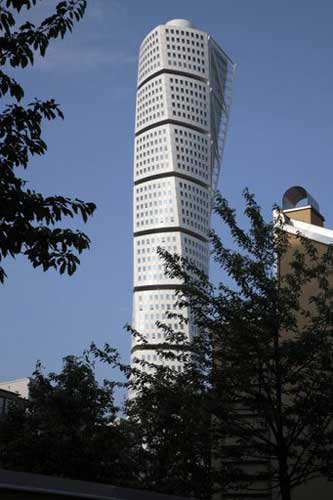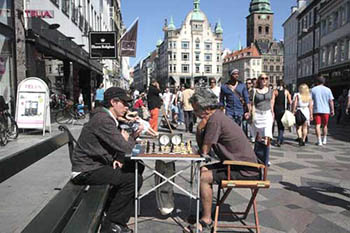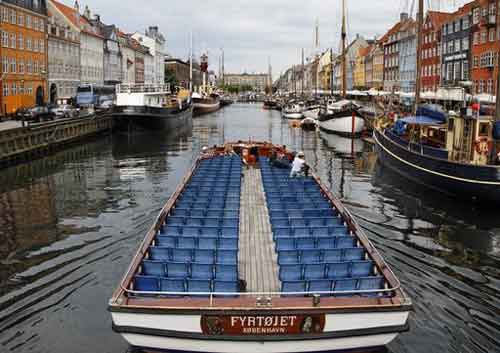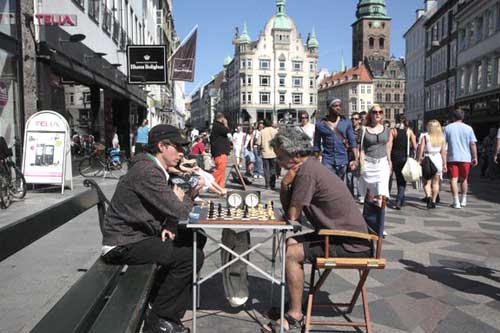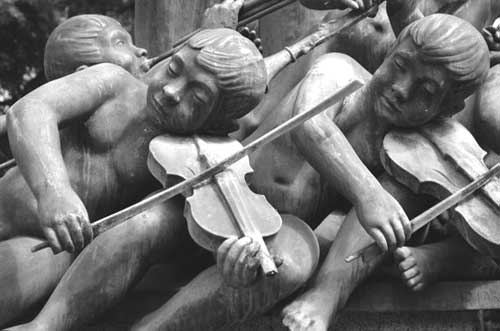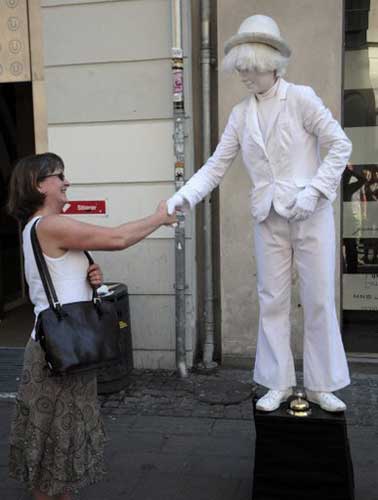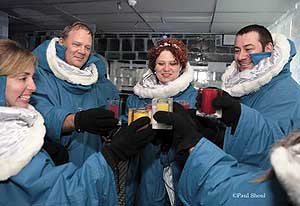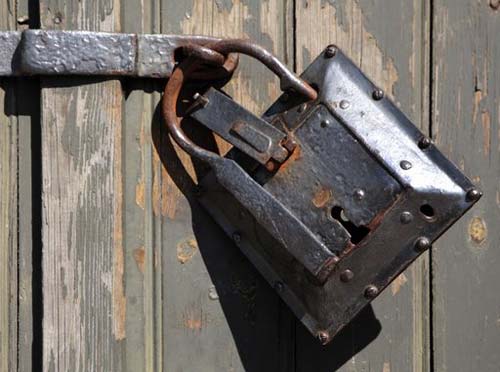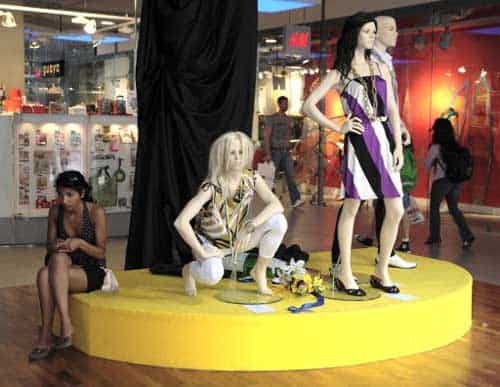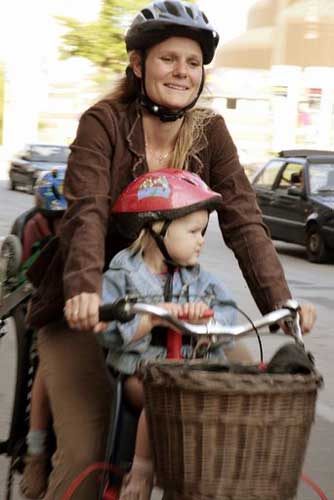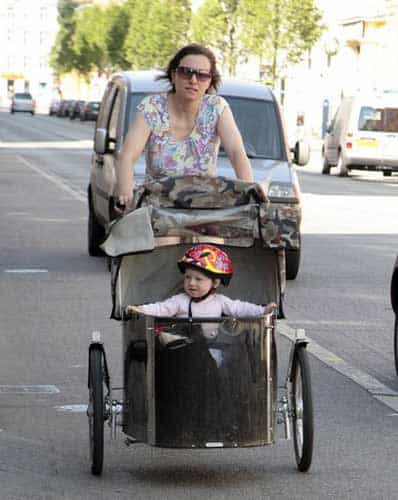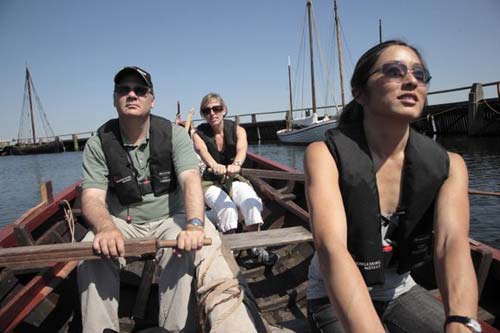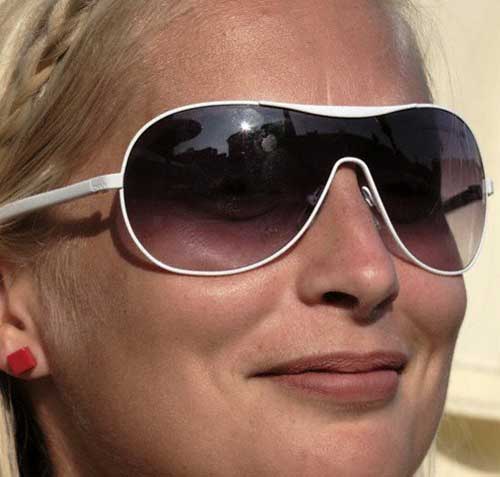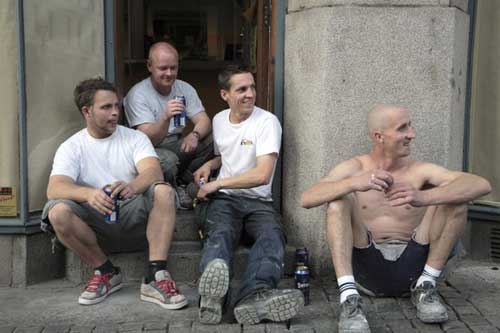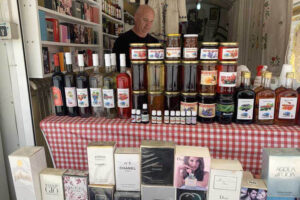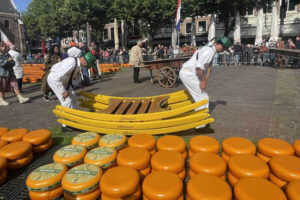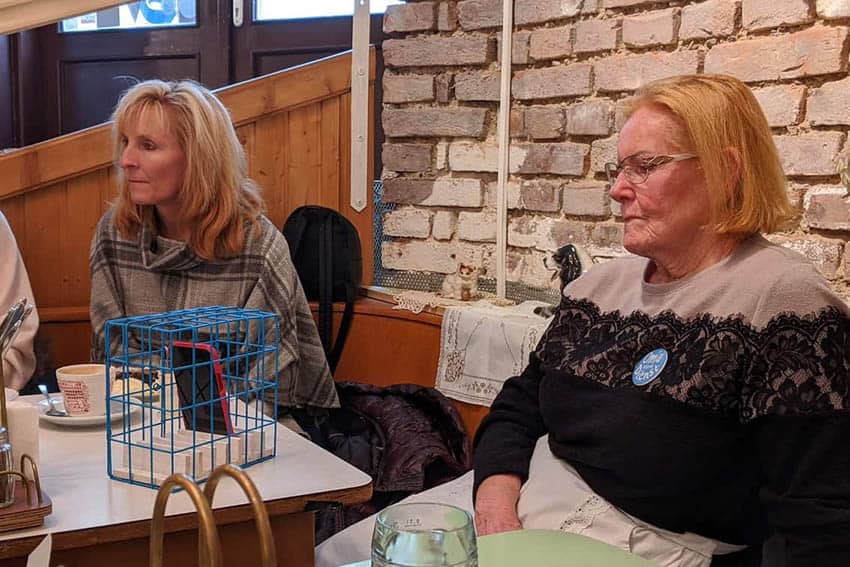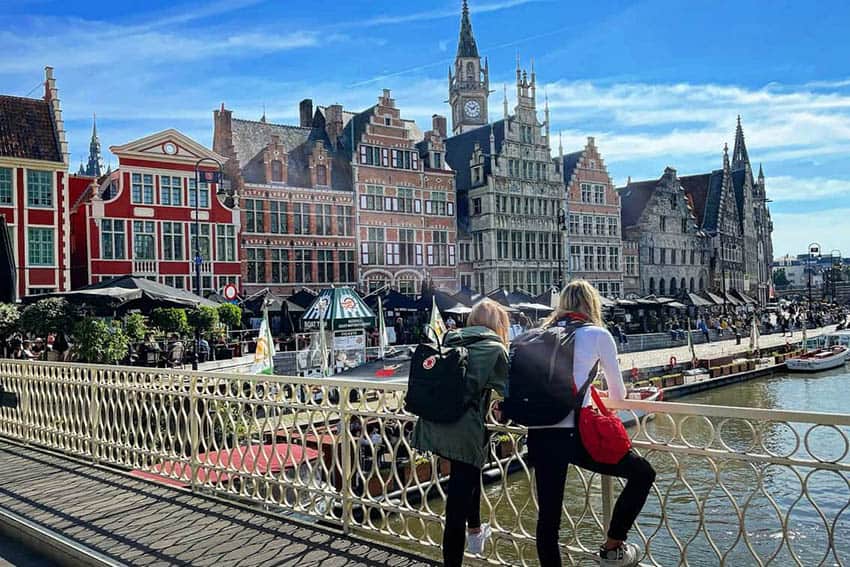Copenhagen, Denmark: How to Eat Herring
By Max Hartshorne
GoNOMAD Editor

Our friendly and outgoing guide Henrik Thierlein told us after we arrived in Copenhagen that herring is the Scandinavian sushi. And that the proper way to eat herring was on a piece of buttered whole grain brown bread, with a fork.
We toured this lovely city filled with canals how else? By boat. There are even boat bus stops, and the canals wind their way in and out of the old city.
We passed by the house that was once lived in by Hans Christian Anderson. We had lunch at ‘The Black Diamond,’ an architectural gem in modern black glass and angles that make you seasick.

We passed the famous symbol of Copenhagen: The Little Mermaid statue. It was surrounded by Japanese tourists, snapping photos. Our ferry boat guide told us that the head had been sawed off twice. But she looks fine today.
Tivoli Gardens
Henrik took us through the Tivoli Gardens. It is so much more than gardens. It has towering amusement rides, swinging chairs a few hundred feet up in the air, a gracious towering theater, and on our visit, a paper facade showed where a new gigantic emporium would be built soon.
After a rest in the cozy Hotel Bertrams, I was recharged. And ready to join my fellow writers Jenny, Lisa, Heather, our guide from NYC, and my favorite shooter, Paul, at a Danish dinner at Tina Baungaard Jenson’s home.
Tina Sums Up The Four Elements of a Tourism Campaign
Tonight we met a young family who lives just outside Copenhagen’s city center. The house was a perfect metaphor, in some ways, for how the people here live. Small, compact, cozy, and well designed.
Tina Baungaard Jensen, who works for Visit Denmark as their international press officer, told us the goals of the country’s marketing, summed up in four words: Simple. Pure. Design. Perfection. The design aspects were everywhere in her little three-story house: elegant orange chairs with a perfect curve, designed by Jacobsen.
A tiny black, round wood stove, only about two feet wide, with a full glass face and a little log storage area below the firebox. Wooden exposed beams in a bedroom that added a natural and outdoorsy look.
Compact Appliances
The appliances in the house were all compact, much smaller than anything you’d see in the U.S. In the finished basement, a tiny corner bathroom with a Liliputian sink in a corner. Tidy stacked half-pint washer/dryer. The small yard had a little greenhouse, and inside, herbs stood ready to pick for cooking, and a tree produced a berry called hyldebomst that Tina made into a refreshing drink, that tasted like lemonade and apple juice.
Her children were delighted to welcome the strange-talking guests from America. Her five-year-old boy named Asgar showed us his bunk beds and his three-year-old brother happily proclaimed, ‘Good night’ in English, (it’s nearly the same in Danish, unbeknownst to us).
Tina’s roast chicken was free-range, and the aoli sauce was a savory dip for the breadsticks. It was a treat to be able to have a family meal here, and learn what daily life is like for a typical Danish household.

Over the Big Bridge to Scania–Southern Sweden
The sun poured into the room at an ungodly hour, so my wake-up call at 7:15 was redundant. It gets light at about 4:30 am here, a long day. We drove over the 16-kilometer (10-mile) Oresund Bridge, a combination of tunnels and graceful sweeping spindles, and drove along the flat green fields of Scania, Southern Sweden.
Our guide, Jessica Jonsson, told us that this was the country’s breadbasket, here most of the country’s white potatoes, rapeseed, and other crops are grown. Windmills slowly twirled in the distance as we drove in the van toward Ales Stenar, all the way on the eastern coast.
Here we saw the stones. We parked next to the rich fishing harbor of Loderup. Up a hill, at the end of a windy path, the Ales Stenar, or Ales stones waited for us. These are 59 boulders standing on end, a sort-of poor man’s Stonehenge, with all of the same mystery and ancient intrigue.
Lined up with the Sun
The position of the stones on either end lined up with the locations of the sun on the longest and shortest days of the year, the all-important solstice. It’s a stone ship and with us were a crowd of teenagers smoking, joshing, and kicking a soccer ball outside next to the stones.
We learned that people in Sweden are taxed far less than their brothers across the bridge in Denmark. And they get paid more due to the higher currency value in Sweden. So many many Danes live over in Sweden and commute using the railway over this bridge to their jobs in Copenhagen.
It’s becoming one region. There was not much of a customs check. We just drove through. By the side of the road, I saw two deer standing in an open wheat field.

Watch Out for Speeding Bikes!
It was a very warm and sunny day in Scania. Here is a bike parking lot near the train station in Lund, a city of about 40,000 where they have preserved buildings that you can explore and see just how people lived back in the 1700s.
I often wish that the US would be as aggressive in promoting bicycle use, it’s such a sensible and friendly way to get around. With bike stoplights and dedicated lanes on nearly every street, it’s plain easier to rely on a bike to get to work.
Sailing Like the Vikings in Roskilde
It’s another sunny hot day in Denmark, and we sailed a Viking boat in Roskilde, just outside of Copenhagen. Our captain spoke in a low voice, telling us to row starboard, or row port, or rest. We made our way out of this harbor. We could see the Viking ship museum on the shoreline.
Tall picture windows framed the relics of the six ships that have been recreated here. A man with a stylus traces the shapes of each plank recovered from the sea, and one-tenth size miniatures can be created. They’ve built a replica of the 30-meter (98-foot) vessel and this summer will sail from here all the way to Dublin!
Wooden Spoons and Forks
Then we had a Viking meal using wooden spoons and forks, simple foods that our host at Cafe Snekkan said were from a menu derived from researching the Viking’s diet. Salmon, roast chicken, salads with seeds and nuts.
“The Vikings, as you probably know, weren’t the nicest people… They marauded, sacked, and took neighboring peoples as slaves,” said our guide Rikke Johansen. “We don’t glorify them or try to say anything different.”

The museum includes a rack full of Viking clothing that people can try on, and pose with swords and long pikes. I took a rare shot of Paul festooned with his cape and sword looking like a fierce marauder himself.
We learned that Danes and Swedes have a word for something that’s very important here. To have a long coffee and conversation, that’s called a Fika.
The Torso Twisted, Where Mystery Drinks Are Served
This oddly shaped skyscraper is the tallest part of the city of Malmo’s amazing transformation. The closing of a Saab plant and a shipyard threw 29,000 out of work.
So the city built this new area of parks, connected housing and common areas, environmentally cutting-edge building and development right in this area where the sea laps the shore. It’s a beautifully designed place for living and like so much in this part of the world, just makes sense.
We had dinner in a restaurant near the bottom of this tower, and they have a two-sided menu. One side is white and is a normal menu. On the back is a black menu that tempts diners and drinkers to ‘visit the dark side,’ and allow the server to choose what you’ll eat and drink. “But if you just want to order a vodka tonic, go ahead.”

The Gold Coast to Elsinore and Kronborg Castle
On our last full day in Denmark, we drove up the coast to Elsinore and Kronborg Castle, the setting of Shakespeare’s Hamlet. It’s a spectacular coast and worth exploring.
It was a gloriously sunny day, a good day for the beach. The houses here on the gold coast toward the city of Elsinore were stately and set back from the road. It was, as our guide told us, the high-rent district.
We pulled into where a ferry dock that goes back and forth between Denmark and Sweden. They were going to build that big connecting bridge between the two countries here instead of where the Oresund bridge is now.
It would have made sense since it is about a third of the distance of the longer span further south. But the currents of the water somehow made this too difficult. In the distance, we could see Kronborg Castle, a huge square edifice with towers… This was the famous castle where Hamlet was set.
Inside we saw what you’d expect inside a castle — a vast courtyard, tapestries, paintings, and old furniture. But in another wing, there was a maritime museum that fascinated me, though I was the only one of us who wanted to see it.
The museum showed lifesize depictions of what cabins on freighter ships looked like and some of the models showed modern containerships, groaning with hundreds of stacked containers. They fall off the ships in heavy seas, I’ve heard.
Ship models of all shapes and sizes waited inside glass boxes. I read a story about Jonas Bronk. In 1639, he bought a 40-square-mile tract of land from the local Indians. It was later known as the Bronx. More than 300,000 Danes emigrated over to the US during the heyday of crossings. It reached its peak in 1910 when one million immigrants came to the US.

Some of the ships in the museum were built just to carry this massive wave of humanity. The flow of people continued until about 1921 when quotas began to be put into effect.
The ships carried fewer and fewer immigrants and tried to revive their business by taking immigrants back the other way. By the mid-thirties the ships were sold off, there was not enough traffic to keep them going.
I also learned that early in the 20th century, the Danes sold the island of St. Thomas to the US for $25 million. Without slaves, their businesses there were not worth pursuing.
Dinner at Jacob and Pia Marie’s: The Art of Conversation
Our last night in Copenhagen was our best. That’s because we met such interesting people and learned all about their lives at an intimate dinner party held in a spacious art-filled apartment in the city.
Jacob Termansen and Pia Marie Molbech are a glamorous and successful couple who photograph top hotels together around the world. They create coffee-table books showing luscious photos of the properties and of high-end homes. He shoots the photos using a 6 x 8 format camera and Pia Marie styles the sets. It’s a wonderful arrangement that brings them to Singapore, the US and to this art-filled apartment at different times of the year. They also visit hotels on islands around the world for their shoots.
I sat next to an architect named Torsten who designs buildings in Denmark, Greenland and Kuwait. He told me about the 18 families who run the gulf country — there are only about 700,000 natives and more than two million guest workers who handle the work. He said the competition is tough — there are a lot of hungry architects from Egypt, Pakistan and other places so he has to work for much less there. But he likes the work and has many projects underway. He does city planning and large developments.
Jacob, a tall bearded man with an easy smile, showed us around his large apartment where original artwork filled every wall, and the ceilings were about 12 feet high. On one shelf stood an assortment of phalluses, from nine inches all the way up to three feet. Down on the floor was a cast of upturned pudenda, looking appropriate there with all of the penises on the shelf above. In each room the artwork called out at you, it was attention-grabbing and one-of-a-kind throughout.
We also met a woman who works at a Copenhagen free daily newspaper. It’s one of four such freebies in a viciously cut-throat market where the press not only gives the papers away, but home delivers more than 500,000 copies to nearly every household in Denmark. “We are losing about $200,000 per day on this,” she said, “but we have to do it so that the outsiders (a company from Iceland) doesn’t gain a foothold here.”
The mark of a good dinner party is how long you stay seated at the table. With our vigorous conversation and an interesting company, we sat from 8 pm til 1:30 in the morning. It was a fine way to end this visit to Denmark, a country whose people have proved to be among the most dynamic and interesting in the world!
Denmark & Sweden Photo Gallery by Paul Shoul:
- Skiing in Georgia - February 21, 2024
- Exciting Rail Travel News in 2024 - February 4, 2024
- Last Minute Gifts for Christmas - December 17, 2023

